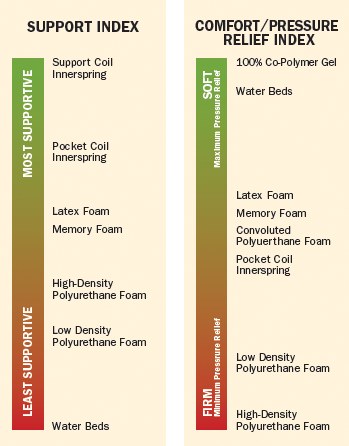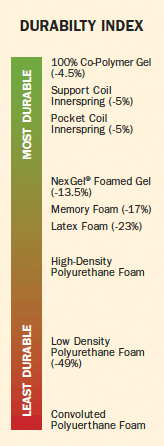New York's highest court of appeals has held that no-fault insurers cannot deny no-fault benefits where they unilaterally determine that a provider has committed misconduct based upon alleged fraudulent conduct. The Court held that this authority belongs solely to state regulators, specifically New York's Board of Regents, which oversees professional licensing and discipline. This follows a similar recent ruling in Florida reported in this publication.
They Sleep Well, They Get Well
That simple question, "Doc, which mattress is best for my condition?" might be more important than you think. Research shows most people are sleeping on the wrong mattress; one that is not supporting and cushioning properly. That means the excellent work you do during the day aligning some of your patients is being undone at night by their mattress. This can make some patients frustrated and lead them to question you and chiropractic care in general.
Patients need advice about how to properly support their body during sleep. They are listening to retail mattress companies; getting bad advice and sleep related problems are growing. Recent studies show that sleep is a major health concern in the United States: 70 million people report they suffer from sleep related pain and, on average, we are sleeping 30% less than our parents did. Medical research has linked sleep problems with disease, especially diabetes, stroke and obesity.
There are four stages of sleep and REM (rapid eye movement). Sleep studies show that at stages three and four, the brain nourishes and repairs the body. Hence the term "deep, healing" sleep. The use of sleeping pills and frequent tossing and turning, however, prevent the patient from experiencing deep, healing level sleep. Currently, there is no "go-to" health care professional recognized for providing accurate advice about sleep and the benefit of a wellness, quality mattress. The doctor of chiropractic armed with the research can fill this void.
Mattress Structures
The modern mattress is made of three parts.
- The support layer, whose sole job is to provide support for the spine. We're told to sit up straight and stand up straight because the hips should be directly below the shoulder to eliminate stress. Our hip area is normally heavier than our shoulder area so when we lie down we need to "push" the hips up into alignment with the shoulders. For that reason, many doctors recommend a firm bed to provide proper support. Unfortunately, the pressure necessary to provide lower back support creates discomfort in the hip and shoulder areas. This causes tossing, turning and eventually, sleep related pain.
- The cushioning layer whose job is to comfort the hip and shoulder areas so the person can sleep. Many modern mattresses rely on synthetic foams to provide this cushioning and it's these foams that suffer from off-gassing fumes and premature wear patterns.
- The base which the mattress sits upon. Typically a box spring unit made of wood and very firm steel or an adjustable base similar to a hospital bed is used to support the top mattress.
So, we see that delivering the ideal sleep surface is a complex feat. If it was simply a matter of comfort, we would still be using feathers and straw like they did in early history. But, proper support means you have to put something that applies pressure to elevate the hip area into a mattress. But how do you get a mattress soft and firm at the same time? The innerspring was invented and revolutionized mattresses back in the 1920's because it provided a way to push the hips up into alignment. But that created pressure which led to new materials and synthetic foams to relieve the pressure.
Water beds were once the rage for their comfort and adjustability, but they failed as sleepers realized they could not deliver proper back support. New foams like memory and latex or air are now trying to displace the innerspring support layer for today's mattress buyer, but third party research reveals these materials fall short when it comes to providing the support, material safety and durability that a mattress would ideally have. The following will show the research in the four critical areas of mattress technology and present some new ways to deliver a better sleep surface.

Back Support Mattress Research
The core system, or support layer, of the modern mattress is what does this pushing and supports the back. The following chart shows how effective the different core systems are at pushing the hips up into the desired alignment position.
By far, the best system is a quality support coil. Support coils are steel springs that are laced together so that they work in unison to prevent the hips from sinking too deeply into the mattress.
In recent years, some mattress manufacturers have replaced these spring core system with foam. This creates a nice selling story of "no wonder your mattress is hurting you, it's full of steel springs." But, foam cores soften over time and lose their ability to support the body properly. For that reason, many patients who purchase beds that use latex or memory foam as their core material begin to feel back pain after a couple of year's use.
Air beds are not included in this analysis because they provide variable support depending on the firmness setting. At soft settings, they provide poor support. At firm settings, they provide good support. Since they allow the user to self-adjust their "sleep number," most sleepers will choose to under inflate the air chamber sacrificing support for short-term comfort, thereby allowing the mattress to create an undesired spinal sag. That is what happened with water beds back in the 1960's and will probably happen again with air and foam core beds.
[pb]Pressure Relief Research
As important as it is to doctors of chiropractic that the ideal mattress properly support the spine, sleep doctors insist it should also relieve pressure under the hip and shoulder areas to effectively promote levels three and four deep, healing sleep. Research shows that even moderate levels of pressure make the sleeper toss and turn which occurs at level one, near wakefulness. The more you toss and turn, the less time is spent at deeper levels of sleep. To combat pressure points, manufacturers add comfort layers to the modern mattress made primarily from different types of foams.
Comfort Index
The Comfort/Pressure Relief Index was constructed using a computerized pressure point mapping system from the medical industry. It ranks how effective the different materials used in mattresses are at reducing a pressure point. Generally speaking, the firmer a mattress, the less pressure relieving it will be; the softer the mattress the more pressure relieving. That is, if you increase support, you reduce comfort.
When new, all mattresses will feel pretty good and by using different combinations of foams, a manufacturer can make them feel remarkably different, thereby, giving the buyer an assortment of comfort levels to choose from. Most mattresses are purchased based upon this "feel" test and price. The ideal mattress would have complete pressure relief in the hip and shoulder areas and firm support for the spine everywhere else. It's this combination of comfort and support that makes mattress construction tricky. One relatively new mattress material, a 100% co-polymer gel (also know as Intelli-Gel®) performed better than any of the foam materials at delivering absolute pressure relief.
Mattress Durability
Most patients buy a mattress thinking it will last for the entire warranty period. But in reality it's more like a car. The car will last, but the tires it comes with wear with use until they need to be replaced. It's much the same with the foam used in mattresses. Durability testing shows that after about three years of use, when foams are used, the cushioning part of a mattress is completely different than when new and by years 5 to 8, it has failed completely. (Source: Leggatt & Platt)

The Durability Index rates the wear factor of the materials used in mattresses. There is a standard industry test for mattress materials. It is called the rollator test and consists of a 6-sided roller weighing 230 pounds that is rolled back and forth over a mattress 200,000 times. This test simulates the amount of wear that will occur as the mattress is slept on during the course of its life. Leggett & Platt, the leading supplier of mattress materials conducted rollator testing on the different types of mattress materials for this index.
It was found that the traditional polyurethane foam used in virtually every retail mattress suffered an astounding 49% rate of change during the test. Popular memory foam showed a 17% change. Latex showed 23%, foamed gels showed a 14% wear while co-polymer gel showed a 4% change, making it the most durable material.
Interestingly, about half of the total wear for these foams occurred during the first 10% of use, meaning that beds that use foam in either the comfort or support layer quickly lose their ability to support and cushion properly. The impact of sleeping on a "worn out too soon" mattress presents a serious concern for both you and your patient. A mattress that fails to provide adequate support at night works against the effort you make during the day to align the patient. That and the poor quality of their sleep makes your work more difficult and, in some cases, impossible.
Add the fact that, unless properly educated, the patient will continue to sleep on this failing mattress thinking it is still okay and that it is their age, overall conditioning or your lack of skill that is really the problem; failing to understand that their mattress is hurting rather than helping them get better.
Mattress Material Safety
Doctors concerned with nervous disorders and allergies want the ideal mattress to contain non-toxic, hypoallergenic, safe materials. When in bed, the patient's respiratory system and brain are very close to the surface of the mattress. Mattress materials are not regulated or rated for safety and manufacturers aren't required to reveal all the materials they are using in a mattress. Research shows than many patients experience problems when they buy a new mattress. Their complaints range from headaches and rashes to more serious issues. For more information on the harmful health effects of different mattress materials visit www.chem-tox.com.
Many of your patients will just go natural to avoid synthetic materials and fire blockers. Unfortunately, its not that simple when it comes to the ideal mattress. Although natural latex is being used in some mattresses, the quality is inconsistent. It can be improved by chemical processing and re-foaming, but then it becomes less natural. Wool is also being used, but a fairly high percentage of people are allergic to both wool and natural latex. Organic cotton is a good, natural, hypoallergenic, non-off gassing material. Co-polymer gel is also good. It is non-toxic, hypo-allergenic, anti-microbial and anti-fungal. It comes from the hospital industry where it is the material of choice for serious wound care patients.
Why Should You Become a Sleep Wellness Expert?
Your patients are already making the connection between proper support, sleep and their health. They respect your opinion as an expert in alignment, support and pain relief. They are confused about mattresses and asking for help. Until recently, the research was not available for you to offer informed advice, but now, it is. Retail mattress companies are misleading your patients and the problem is growing. Research-based, wellness quality sleep products are beginning to come to market. Aligning your practice with these products can increase overall patient care, their satisfaction levels and practice revenue.
Chart Sources: Leggett & Platt; Xsensor Pressure Mapping.


